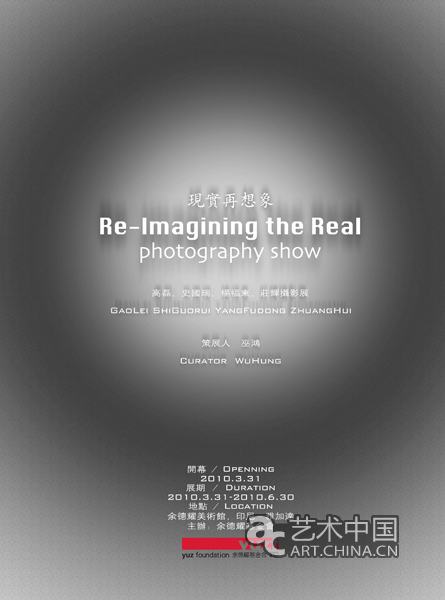
现实再想象——高磊、史国瑞、杨福东、庄辉摄影展
策展人:巫鸿
开幕时间:2010.3.31
展览时间:2010.3.31—2010.6.30
展览地点:余德耀美术馆,印尼—雅加达
主办单位:余德耀基金会
但甚至在观念摄影最为流行的时刻,一些摄影家仍然坚持着摄影的基本性格。他们没有以电脑代替相机,也没有把对现实的解构作为再现的主要任务。这些摄影家中的佼佼者并不拒绝观念的重要性。实际上,正是由于对观念的浓厚兴趣,他们进行了一系列技术和风格的实验,力图扩充纪实摄影的语言和范围,达到观念和写实在一个新层次上的融合。值得注意的是,当数码摄影的影响在近年中开始减弱的时候,这种新型的“观念化”纪实摄影则越来越显示出它的生命力,开始产生一些重要的作品。其引人注目的一个原因是它反映出一种“摄影的回归”(return of photography):人们在其中重新看到了对镜头和光线的使用,重新发现对相纸甚至胶片的敏感,以及摄影家对暗房技术的探索。但这又不是传统意义上的纪实摄影,因为它们对技术的兴趣往往和艺术家的观念密切相关。在这个意义上,这些作品所代表的是一个双重的逆反和综合:在背离观念摄影和传统纪实摄影的同时对二者进行结构和综合,以此建构自身的当代性(contemporaneity)。本次展览中的四位艺术家可以说是这个潮流的代表。虽然他们的风格和技法各不相同,但是他们的灵感都因现实而发,他们的视觉语言都来自摄影的纪实性,但是他们的观念又都反映了强烈而自觉的当代主体性。这些特点导致我把这次展览标题为《现实再想象》---在中国摄影前沿上感触和思考,他们以新的想象力重新接触世界。
——摘自巫鸿《现实再想象》
Re-Imagining the Real -- Photography Show of Gao Lei, Shi Guorui, Yang Fudong, Zhuang Hui
Curator: Wu Hung
Opening: 2010.3.31
Duration: 2010.3.31—2010.6.30
Location: Yuz Museum, Indonesia-Jakarta
Organizer: Yuz Foundation
But even at the point when conceptual photography was at the height of its popularity, some photographers remained loyal upholders of the fundamental nature of the medium. They did not replace their cameras with computers and nor did they regard the deconstruction of reality as the main task of representation. The leading figures among this group of photographers were not rejecting the importance of concept. In fact, it was precisely because of a deep interest in concept that they carried out a series of experiments in technique and style, striving to expand the language and parameters of documentary photography so as to achieve an integration of concept and realism on a new level. It is worth noting that just as the influence of digital photography has begun to decline in recent years, this new type of ‘conceptualised’ documentary photography has more and more shown its vitality and has begun to produce a number of important works. One reason it has drawn attention is that it is a reflection of a kind of ‘return of photography’: people see in it afresh the use of lenses and light, discover anew a sensitivity to photographic paper and even film and to the explorations photographers make of darkroom technique. Yet nor is this documentary photography in the traditional sense, because the interest in technique is usually intimately interlinked with the artist’s conceptual thinking. In this sense these works represent a dualistic rebellion and integration: at the same time as conceptual photography and traditional documentary photography are rejected, the two are reconstructed and synthesised and so their own contemporaneity is made. The four artists brought together in this exhibition can be said to be representatives of this current. Although they differ in style and technique, they all take reality as progenitor of their inspiration; all of them employ a visual language coming out of the documentary nature of photography; but the concepts in their work are also a reflection of a powerful and self-conscious contemporary subjectivity. It has been these particular features that lead us to title this exhibition Re-imagining the Real – thinking and feeling at the very forefront of Chinese photography, they are using a new imagination to make a fresh engagement with the world.
——Excerpt from Re-imagining the Real by Wu Hung